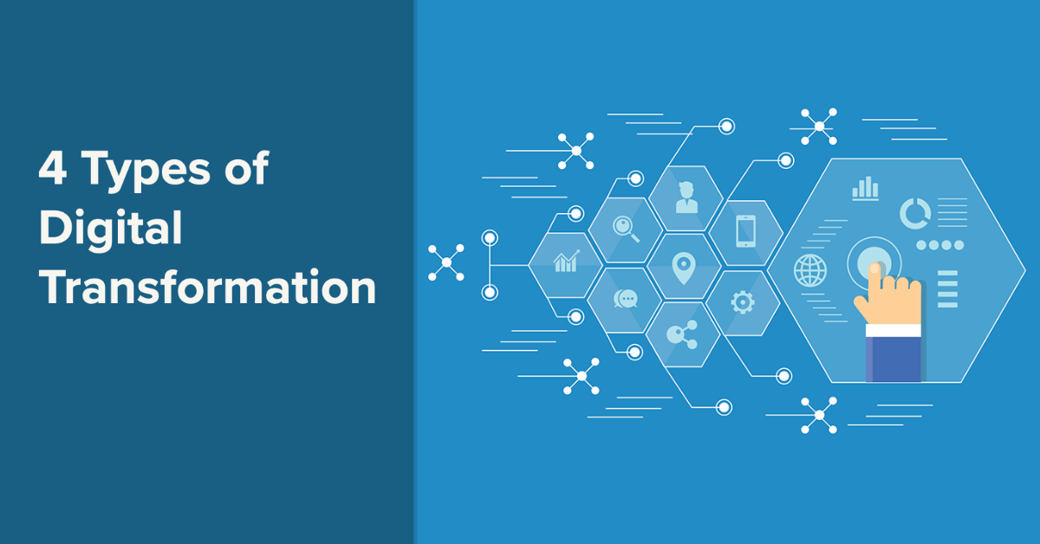Insights
The 4 Types of Digital Transformation
What is digital transformation?
Digital transformation is tough to define because it looks so very different for every industry. Yet, in general terms, it is explained as incorporating digital technology into all business areas. The result is a fundamental change in how businesses function and interact with customers. It is a radical rethinking of how an organization uses technology in conjunction with processes and people to change business performance.
In a perfect setting, a company's digital transformation is led by the CEO, in partnership with the CIOs, CHROs, and the rest of its senior leaders. Digital transformation requires tremendous cross-departmental cooperation within a company to effectively pair rapid application development models with business-focused philosophies.
Usually, sweeping changes in customer expectations regarding products and services or a company's desire to pursue new business models and new revenue streams are the inspiration for a company to undertake a digital transformation.
What are the types of digital transformation?
Digital transformation is not a single massive entity. Frequently corporations are focused entirely on organizational transformation and overlook the fact there are four types of digital transformations. As a result, they’re limiting themselves from taking full advantage of all digital transformation has to offer.
1. Process Transformation
From data, analytics, APIs, and machine learning to other technologies, much focus within the corporate environment has been on new ways to reinvent business processes to lower costs, improve quality, or reduce cycle times. Examples of successful process transformation include companies like Domino's Pizza, where today customers can order from any device. They've entirely reimagined the food ordering process. This innovation has helped them to overtake their rival Pizza Hut concerning sales.
Other companies have implemented robotic process automation to simplify their back-office processes, including legal and accounting as examples. Process transformation can create tremendous value in a company.
2. Business Model Transformation
Process transformation focuses on finite areas of the business. Business model transformations aim at the foundational building blocks of how value is delivered in a specific industry. In essence, companies are using digital transformation to change traditional business models. Examples of this type of reinvention of the business model include Netflix's redesign of video distribution and Apple's reinvention of music delivery: iTunes.
3. Domain Transformation
A prominent example of how domain transformation works is the online mega-retailer, Amazon. It marched into a new market domain with the launch of Amazon Web Services (AWS) and is currently the largest cloud computing/infrastructure service in a formerly owned field by giants such as IBM and Microsoft. AWS is a clear example of how new technologies redefine products and services, blurring industry boundaries and creating entirely new sets of non-traditional competitors. Domain transformation currently offers one of the most significant opportunities for company growth.
4. Cultural/Organizational Transformation
A redefining of organization mindsets, processes, talent, and capabilities for the digital world is always needed to achieve long-term digital transformation for any industry. The most successful corporations recognize digital transformation requires a flexible workflow, a decentralized decision-making process, a bias toward testing and learning, and a greater reliance on different business ecosystems.
One of the best examples of this cultural/organizational transformation is the consumer credit agency Experian. It was able to change its organization by instilling collaboration and agile development into its workflows. Additionally, it spearheaded a fundamental shift in employee focus from equipment to data throughout the company.
What are the three approaches to digital transformation?
1. Wait for proof of digital success
This first approach will help organizations focused on empirical results. The difficulty with this approach is the tremendous risk of remaining idle until your digital transformation catches on. It provides competitors with a distinct advantage if their digital success happens faster than it does for your company. Since most organizations have a mixture of digital and non-digital solutions, this first approach is usually the first choice for most companies.
2. Develop an all-inclusive digital strategy
This approach focuses on getting the strategy as complete as possible from the start. It requires a robust long-term plan. The all-inclusive digital transformation strategy focuses on changing the culture and rapidly implementing innovation. It is usually quite an expensive approach with many dangers. Businesses with great patience and an appetite for risk need only apply!
3. Incremental delivery of digital skill
This approach focuses on delivering benefits as a company moves toward a potential changing digital destination after identifying an initial target and route. But as the organization progresses, lessons learned and new inputs are considered, thereby changing the digital goal and sometimes the path to the destination. Therefore, this approach concentrates on delivering a solid yet malleable strategy that can evolve with industry changes throughout its lifetime.
Why does a company need digital transformation?
A company may take on digital transformation for several reasons. However, the most crucial reason is basic economic survival. COVID-19 illustrated the importance of adapting quickly to dramatic changes, including disruptions to supply chains, time-to-market pressures, and rapidly changing customer expectations. Spending on the digital transformation of business practices, products, and organizations has never been more critical for its survival.
Which digital transformation type is suitable for you?
Digital transformation varies greatly depending on a company's industry, specific challenges, and demands. But one constant is the more technology changes, the more companies will need to adapt.
With our broad industrial reach, our clients achieve the digital transformation they desire. We’ve built a foundation of over a decade of experience and research data to prove what works and fails in each specific industry. Businesses who pursue digital transformation will benefit from the results and enjoy vaster success than those who don't. If you’re ready to start your transformation, let us know today, and together we can decide which approach is right for your business.



